Famous for its five tall temples that soar high above the jungle canopy, Tikal archeological site is bound to impress anyone who visits. The Mayan ruins of both Tikal and Yaxha in northern Guatemala, allow visitors to travel through time while exploring the ancient wonders of the Mayan world.
A Little About the Mayans
As one of the first indigenous groups to settle in Mesoamerica, Mayans spread across Mexico’s Yucatan peninsula and north into the Mexican states of Tabasco, and Chiapas. They also went south into Guatemala, Belize as well as parts of El Salvador and Honduras. Other parts of early Mesoamerica were inhabited by Zapotec and Olmec peoples. We’ll talk about these cultures in our posts from Mexico (Coming Soon).

The Maya people were very advanced, excelling in math and astronomy. Using this knowledge, they developed one of the most accurate calendars with 365 days separated into eighteen 20-day months and one 5-day month. They used hieroglyphics with 800 characters to tell their stories, legends and history.
One of our guides explained that the Maya people were not empire builders but instead built independent cities and states. They shared common religious beliefs, customs and language with each other but remained independent. Communities developed cooperative relationships with some of their neighbours while being at war with others.
Exploring these cities is a great way to further understand this fascinating culture.
Tikal
Located in northern Guatemala, in a region often called the Maya Forest, are the Mayan ruins of Tikal. The city was established around the 4th century BCE making it one of the earliest known Mayan settlements. It grew to be one of the largest and most important cities in the area for culture, religion and trade. Tikal remained as a powerful city for a remarkable 1500 years until around 900 AD.
The city lay covered by the dense Guatemalan jungle until the government sent researchers to the area in 1848. This was soon followed by British, Swiss and German archeologists who began to uncover the massive city. Its original name is believed to be Yax Mutal, but was named Tikal when it was rediscovered; a word that may have been taken from either the Itza or Yucatan Mayan languages.
At its peak, around 750 AD, it had over 3,000 buildings spread across 16 km² (6.2 sq. mi.) that included pyramid-style temples set around open plazas, with palaces, ball game courts, residences and markets. The population at that time was at least 60,000. Approximately 700 of those were royalty and elite society. Only about 10% of the large city has been uncovered today. Many of the buildings have been taken over by the jungle. A lot of those are considered too unstable to uncover so will be forever lost.
The oldest buildings found date back to the 4th century BCE, but most of the temples that we see today were built between the years 250 – 900 AD.
Great Plaza
The main site in the large city of Tikal is the famous Temple of the Great Jaguar standing tall at the end of the Great Plaza. Formally it’s called Temple I, but that plain name doesn’t hint to how pretty this building is. It is so striking, that it is a symbol of Guatemala.

At 47 m (154 ft) tall, the 9-tiered pyramid looks very impressive. It received the name Temple of the Jaguar because a wooden lintel above the main door had a carving of a jaguar. When researchers entered inside, they found the tomb of the 26th Mayan ruler, Jasaw Chan Kʼawiil, who is also named Ah Cacau (Lord Chocolate). Inside the tomb they found a carving of Lord Chocolate sitting on a throne decorated with a jaguar carving. Archeologists also found precious jewels in the tomb such as jade, Caribbean pearls, alabaster as well as finely decorated pottery. He was considered the best ruler of Tikal.
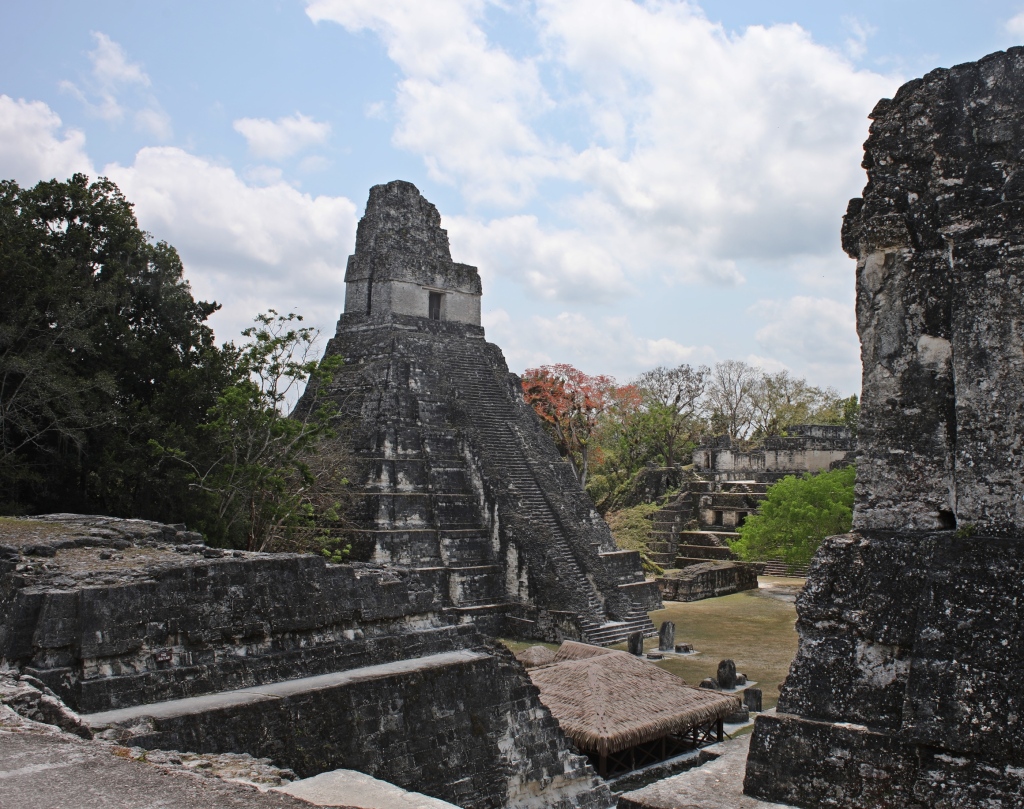
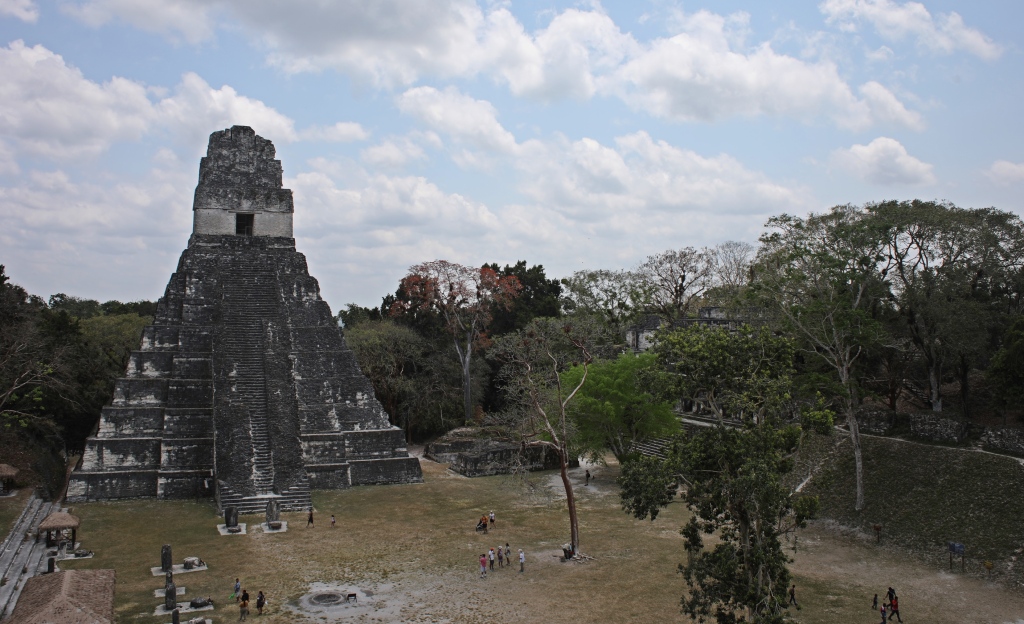
Across from this impressive pyramid is another one that is only slightly smaller. At 38 metres (125 ft) tall, Temple 2 is also called Temple of Masks because there are two stone masks on either side of the stairway. This temple was built in 700 AD as a tribute to the wife of Lord Chocolate, Lady 12 Macaw. A wooden lintel inside depicts a woman believed to be Lady 12 Macaw. Researchers believe she is from Yaxha, which is the site we visit next (click here to go directly to Yaxha).

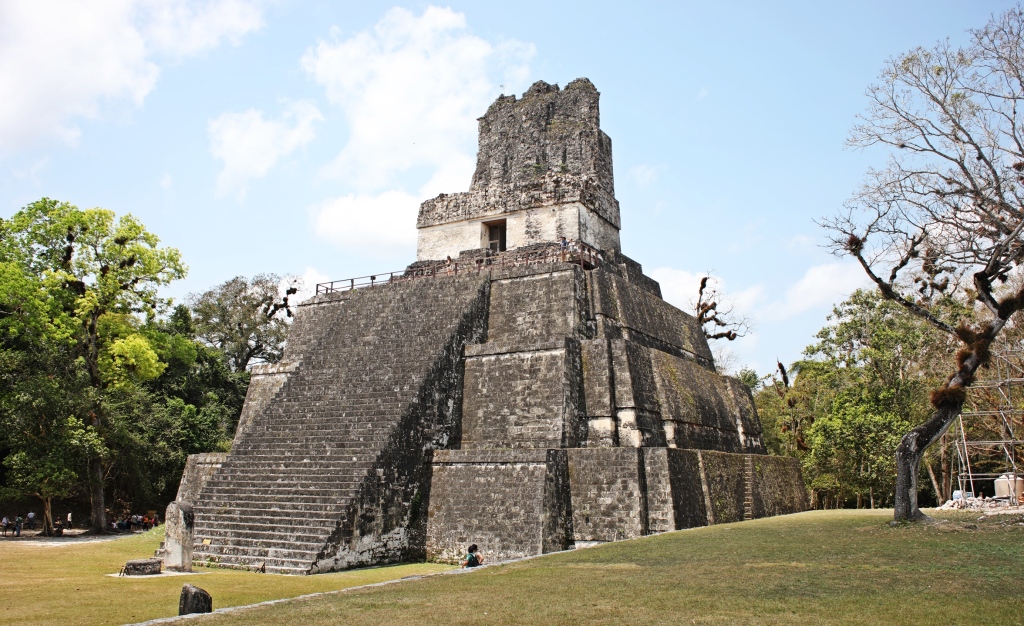
We didn’t expect to still be allowed to climb any of the pyramids at Tikal, but you can climb to the top of three of them. One of those is Temple of Masks. From the top we had a great view of Temple of the Great Jaguar on the other side of the greenspace.

Did you notice a chocolate theme yet? Mayans are the original chocolatiers. We can thank them for being the first to cultivate chocolate as well as chili peppers, vanilla, papayas and pineapples.
On either side of the Great Plaza are the remains of the 4th century Palace of the Nobles and a necropolis. In front of the necropolis are many carved stone monoliths, called stelae. Many of these stelae are carved with hieroglyphs that describe historical events and rulers of the city.
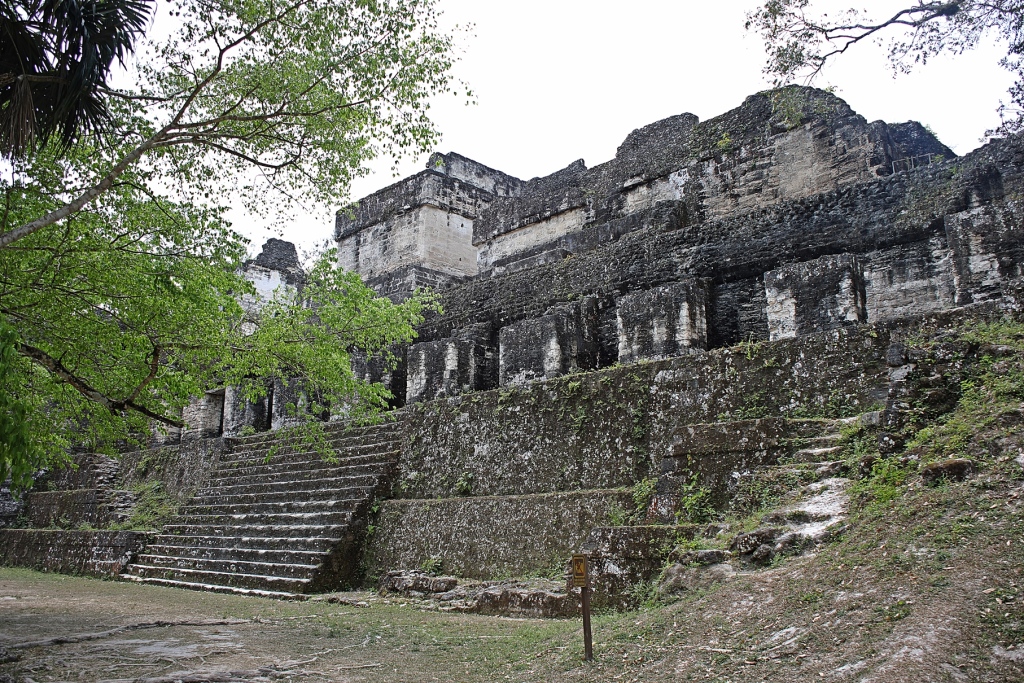
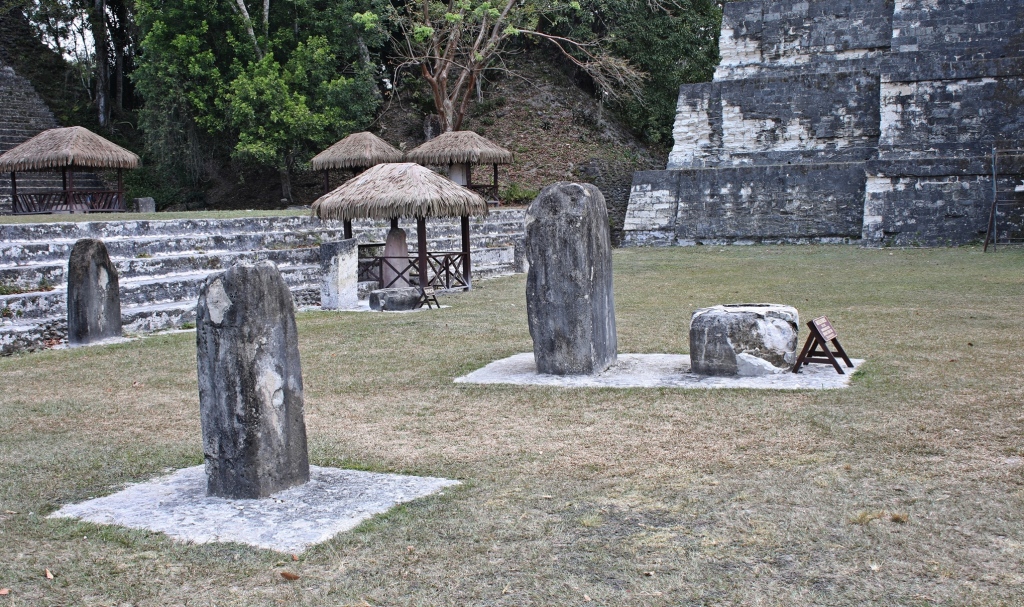
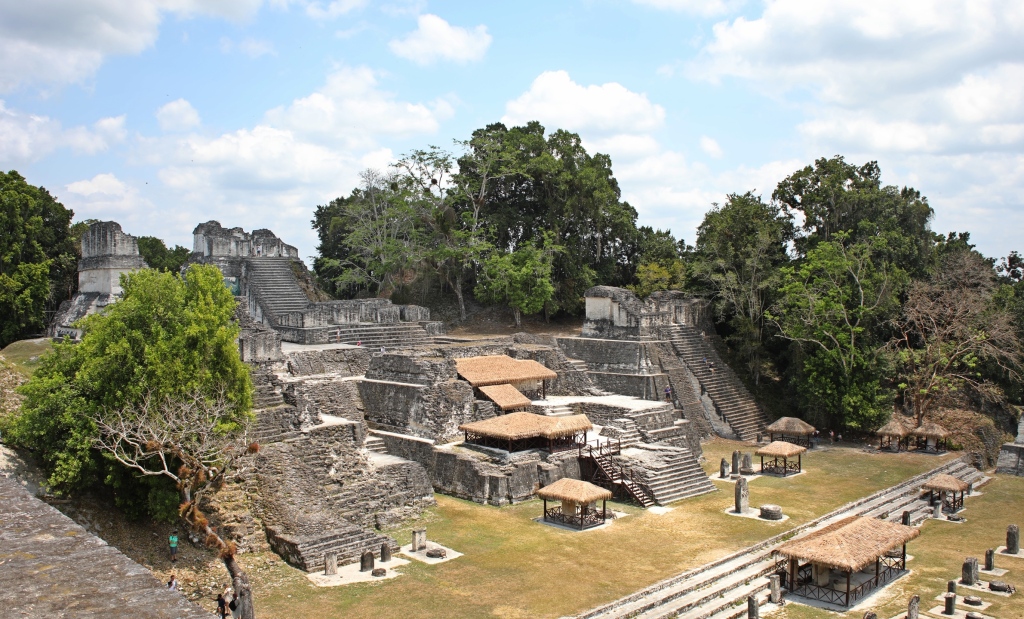

The most important stelae are kept under protective palm leaf roofs. One is of Maya rain god Chaac (250 BCE). In a land where the collection of rain water is the primary source of water, you can imagine how important Chaac was to them. We’ll show you carvings of Chaac in many of the Mayan sites we visited. A different version of the rain god can be found throughout the Mesoamerican civilization such as Cocijo by Zapotec and Tlaloc by Mexicas.
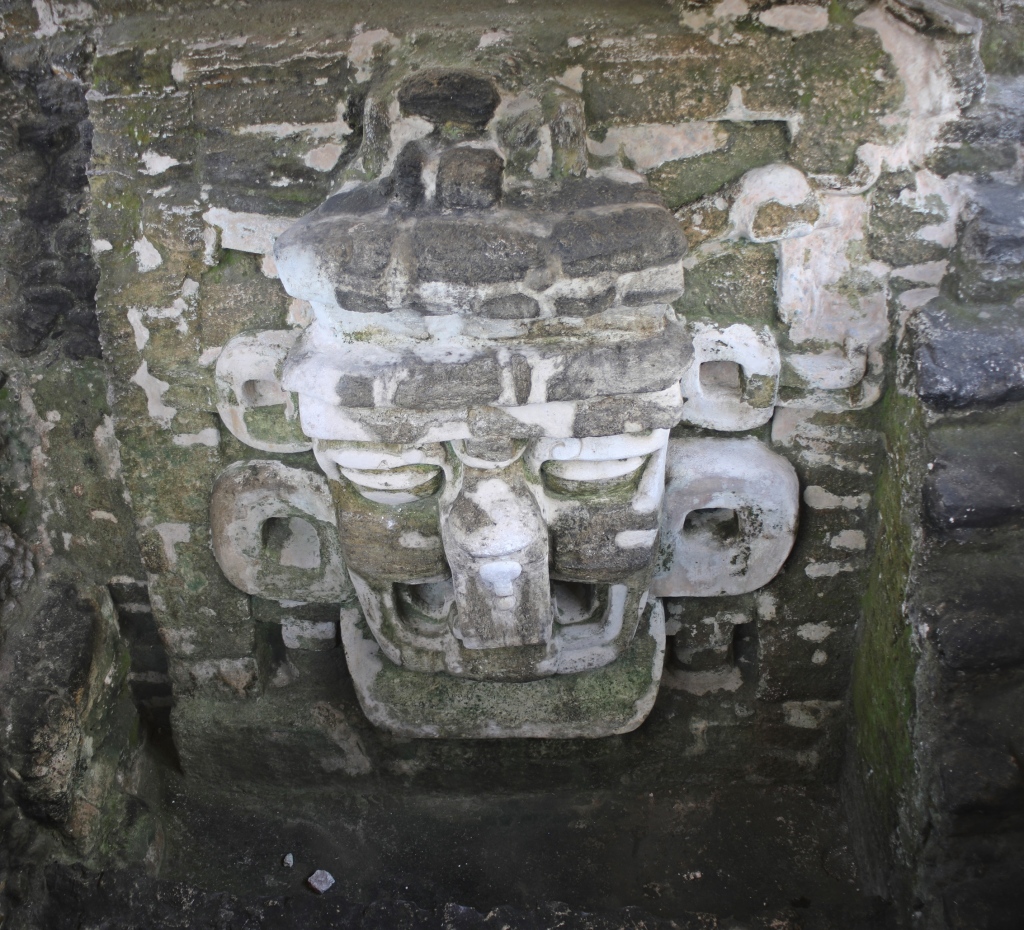
Wildlife in Tikal
As we walked through the jungle between pyramids we were surprised to see so much wildlife. There were coatis, howler and spider monkeys as well as colourful toucans.
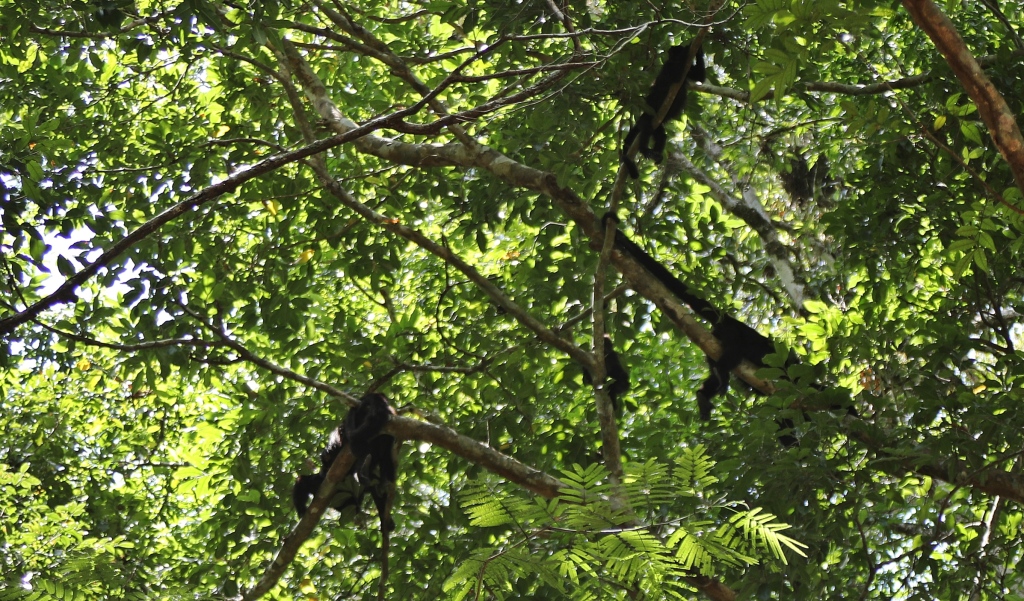
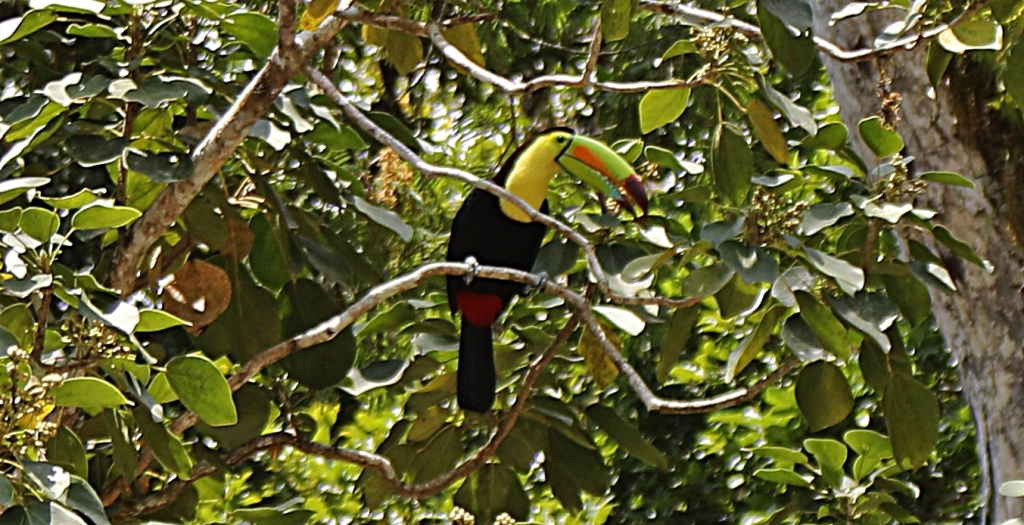

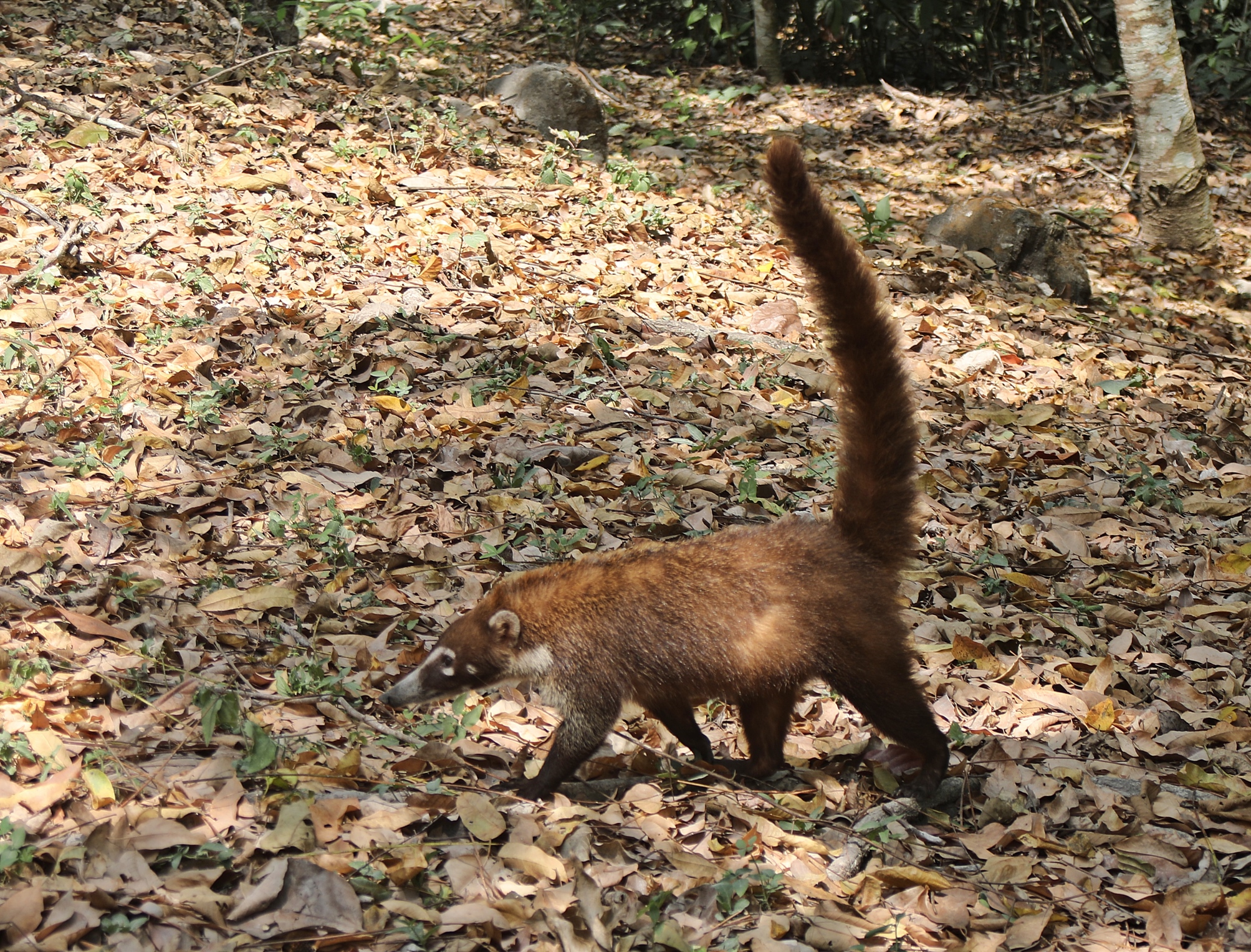
We also saw many huge Ceiba trees. They are sacred trees to the Maya because they connect the living world to the underworld. They’re the national tree of Guatemala.

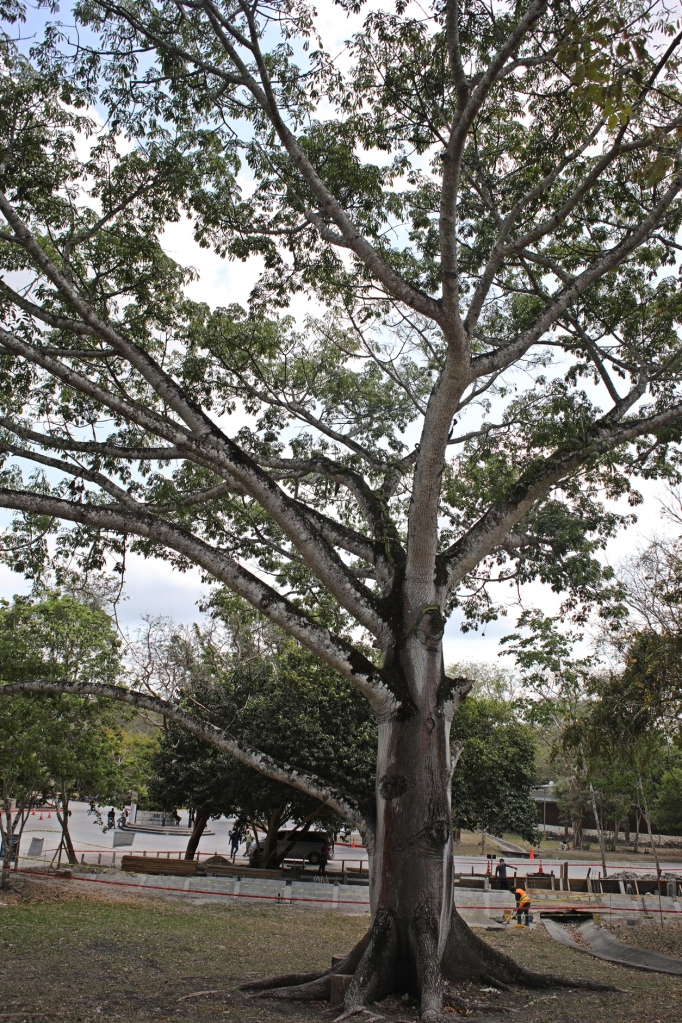
The Lost World Complex
After walking through the jungle we reached El Mundo Perdido (The Lost World) Complex. It was the first complex to be built in Tikal, and its main pyramid dates to 700 BCE. That original structure is buried deep beneath four others so that the one we see today dates to 1 AD, which is still remarkably old.
On the front of the temple two Jaguar masks that are said to protect the stairs. They are in very poor condition though, and we wouldn’t know what they represented if we weren’t told.

This tall pyramid was used as the primary spot for astronomical observations in Tikal. Astronomers noted the positions of the sun as it rose and set as well as the movement of visible planets such as Venus. Buildings with notched roofs were purposely built in front and behind the pyramid to track the sun’s location at certain times of the year.
We climbed to the top of the astronomical pyramid for an amazing view. This was our first glimpse of Temples III and IV. We could also see the tops of Temples I and II poking up from the dense jungle.
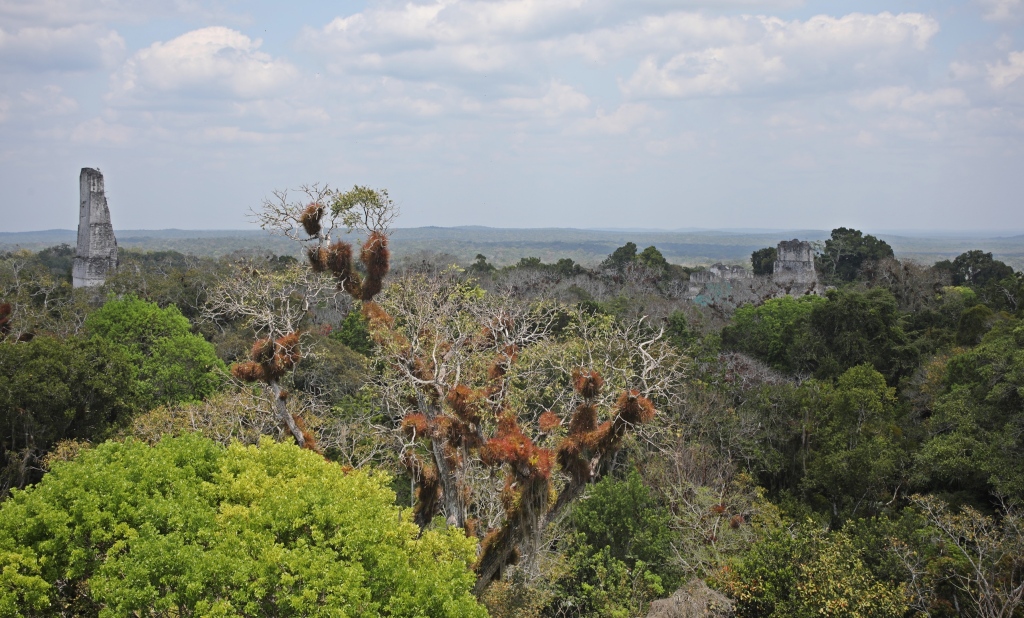

Also in The Lost World Complex is a temple that was built in a different architectural design called Talud Tablero style. It was a typical style for buildings in Teotihuacan, near Mexico City, but not in most Mayan cities. Researchers believe that it was built by people who came to Tikal from Teotihuacan in the 4th century. It’s staggering to think of the voyage they undertook from Teotihuacan, which is over 600 km (1,000 miles) away. Eventually Teotihuacan rulers ended up taking over Tikal in 378 AD.
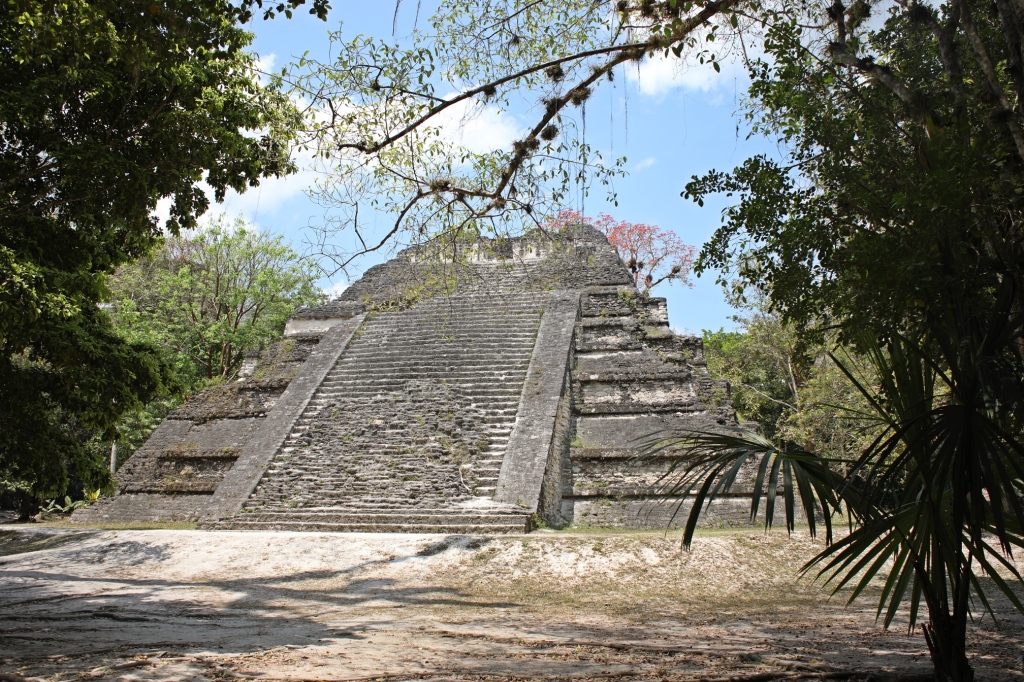
Temple IV
We saved the tallest temple in Tikal for last. Temple IV stands a whopping 65 metres (213 ft) tall. It is named Temple of the Double-Headed Serpent because of engravings found on the pyramid. The bottom of Temple IV has not been restored so climbing on it is not possible. Instead, a wooden staircase of 270 steps takes you to the top for the most famous view of the park. Standing high above the trees we could see Temples I, II, III and Perdita Mundo Pyramid towering over the jungle canopy. It was an awesome view and we were glad it was saved until the end. Some tours come to watch sunrise from this viewpoint, but we were happy to have the soft, late afternoon light we experienced.
This scene was made famous in Star Wars IV. Here’s a link to the Star Wars scene if you’re interested.
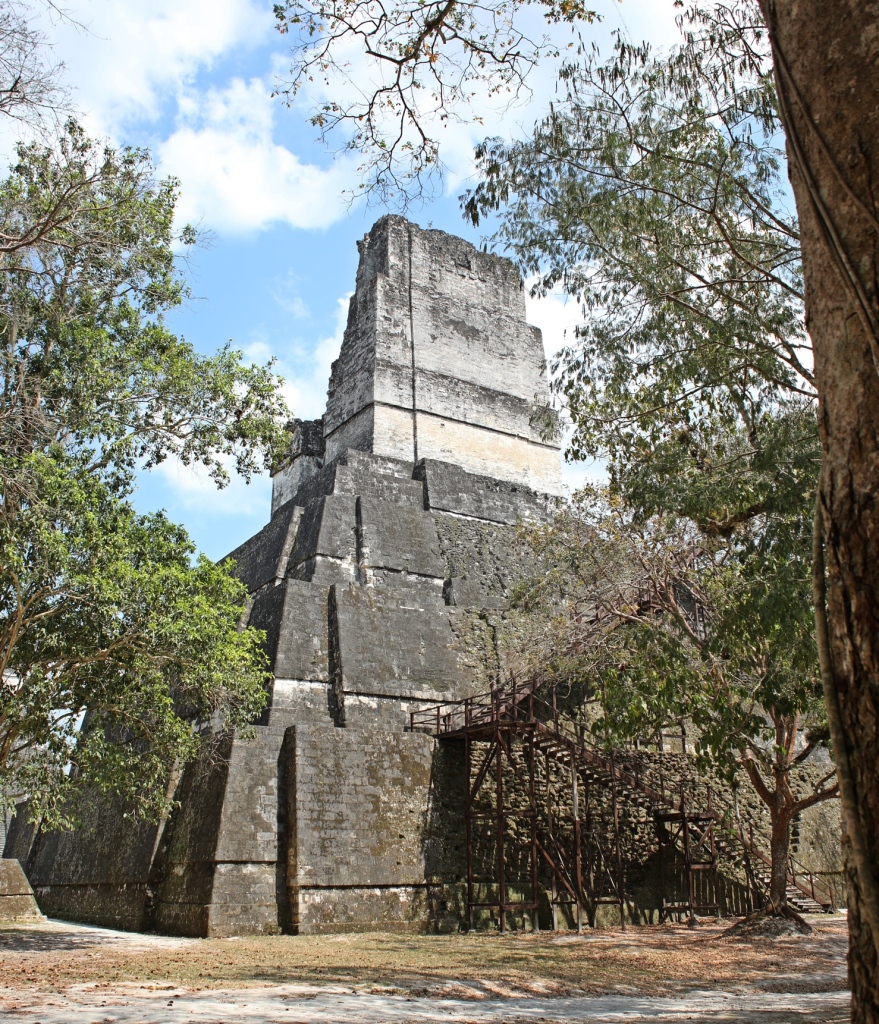

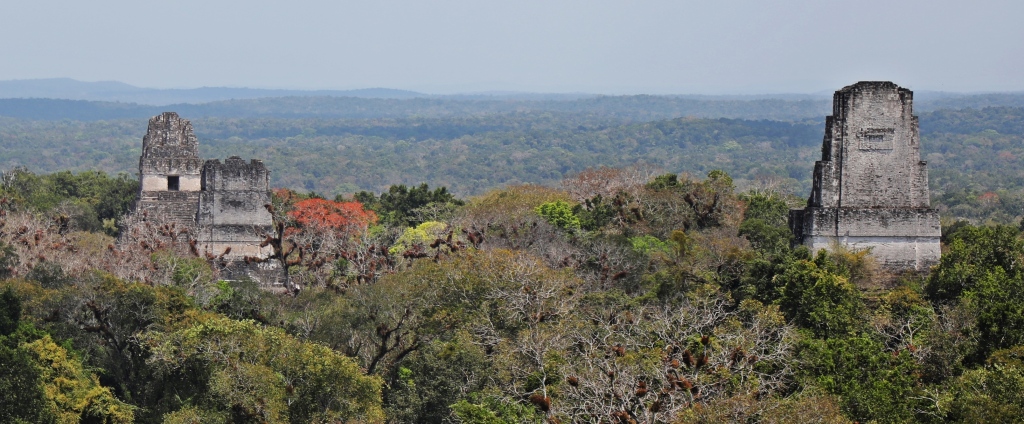
Entrance fee – 150Q ($20 USD); Opening Hours – 6 am to 5 pm every day. You must show your passport to purchase a ticket.
Yaxha
Not far from the famous Mayan city of Tikal, is another site that should not be missed. Yaxha (pronounced Ya-Sha) was established a few hundred years after Tikal, around 600 BCE. At its peak, in 800 AD, it had a population of 20,000.
It was abandoned in 950 AD. As with many Mayan cities, the reason for abandonment is not exactly known but was assumed to be the result of a number of factors such as drought, wars and famine. Recently researchers have uncovered another reason. Yaxha is located on the Petan Basin which was mostly composed of limestone ridges. There were no natural rivers or lakes in the basin. Their only water source was rainwater that they collected in pools that they dug around the edge of the city. Many Mayan tombs and funerary items were painted red/orange hues made from mercury ridden cinnabar. Researchers have recently discovered that the pools used in Yaxha and Tikal were laced with mercury from cinnabar, as well as cyanobacteria. It is now believed that their water was contaminated and likely played a large part in the mass exodus from these cities.
North Acropolis
The North Acropolis is the prettiest square in Yaxha. The pyramids in this plaza have similar construction to one that was found in El Mundo Perdido in Tikal. Both were built in a style typically used in Teotihuacan, in central Mexico, called the Tablero Talud.
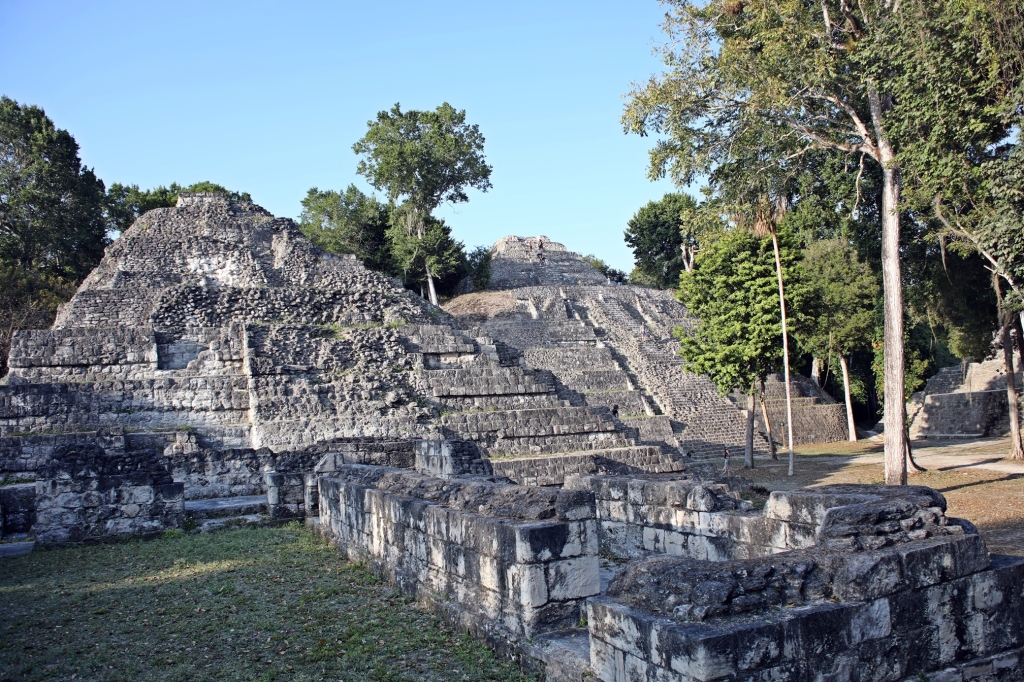
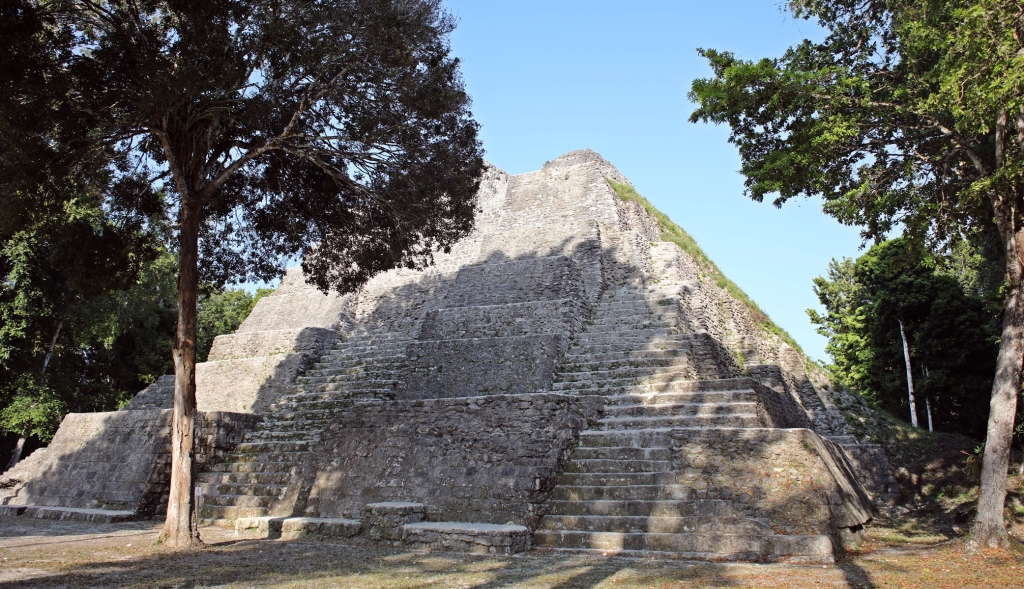
We climbed to the top of two pyramids in the square where we were treated to views of the other pyramids in this plaza, as well as the tip of Temple 216, far in the distance.

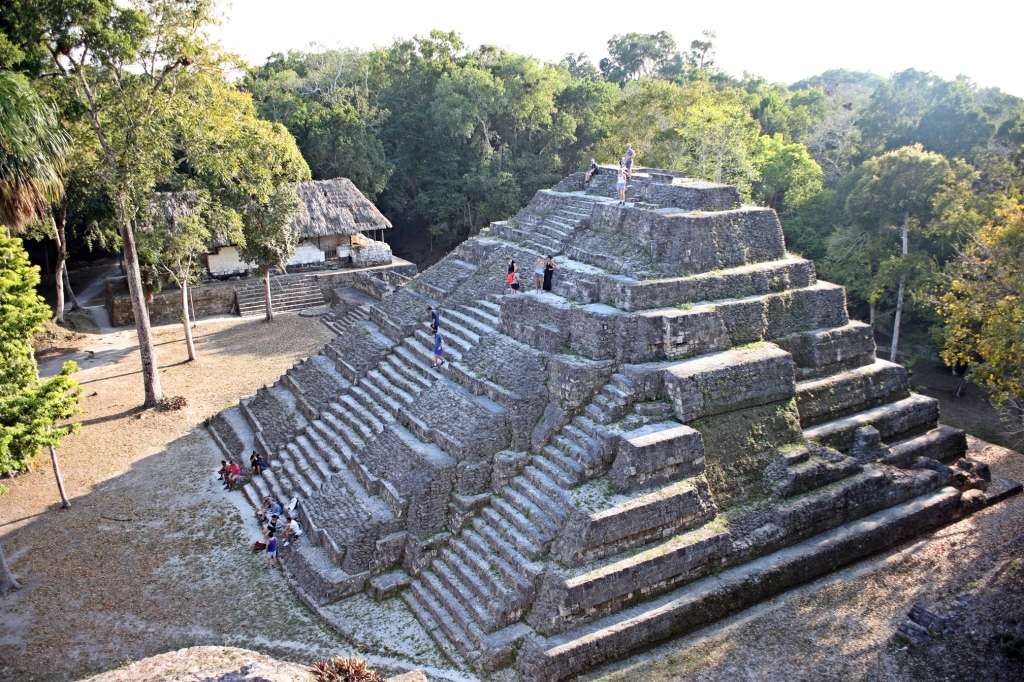
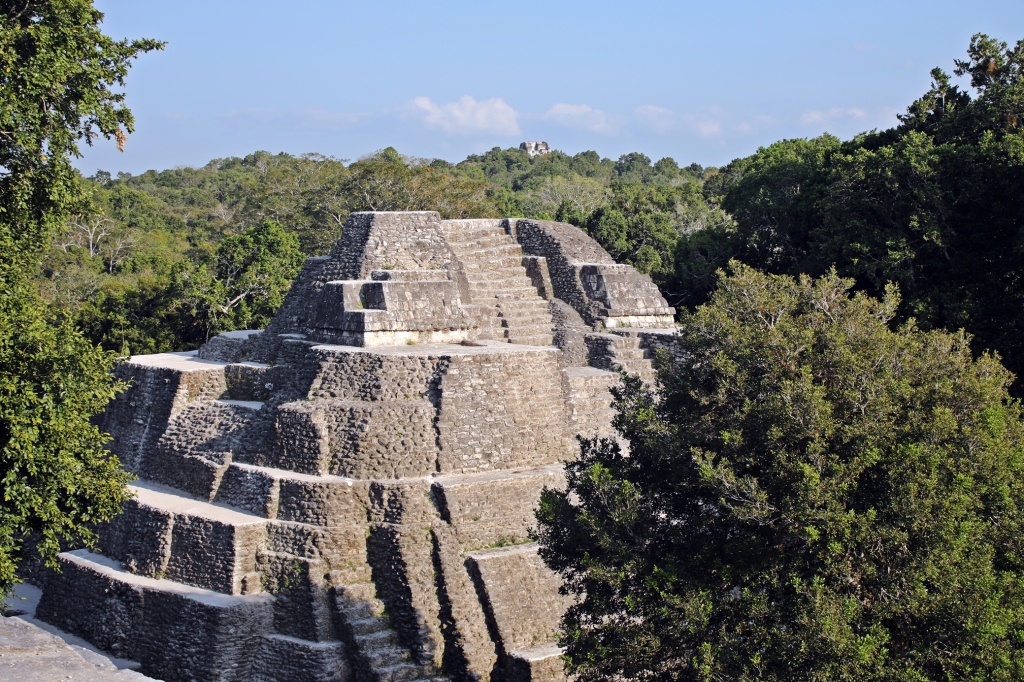
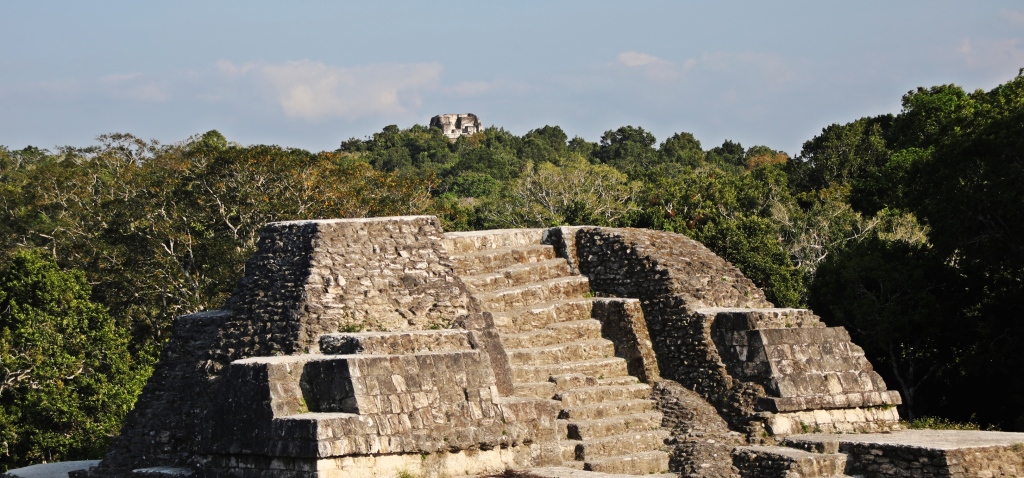
As we explored Yaxha we saw many unnamed stone pyramids and palaces. Unlike most Mayan cities almost all of the stelae found were too worn to allow researchers to read the hieroglyphics. As a result there are still a lot of unknowns to the city. Many of these buildings were simply numbered, without many details on their history.


One stela that is in good condition is Stela 11. It is carved with an image on it that is either, a Teotihuacan warrior, or the Mexica rain god Tlaloc. Either way, it was not carved by Mayans.
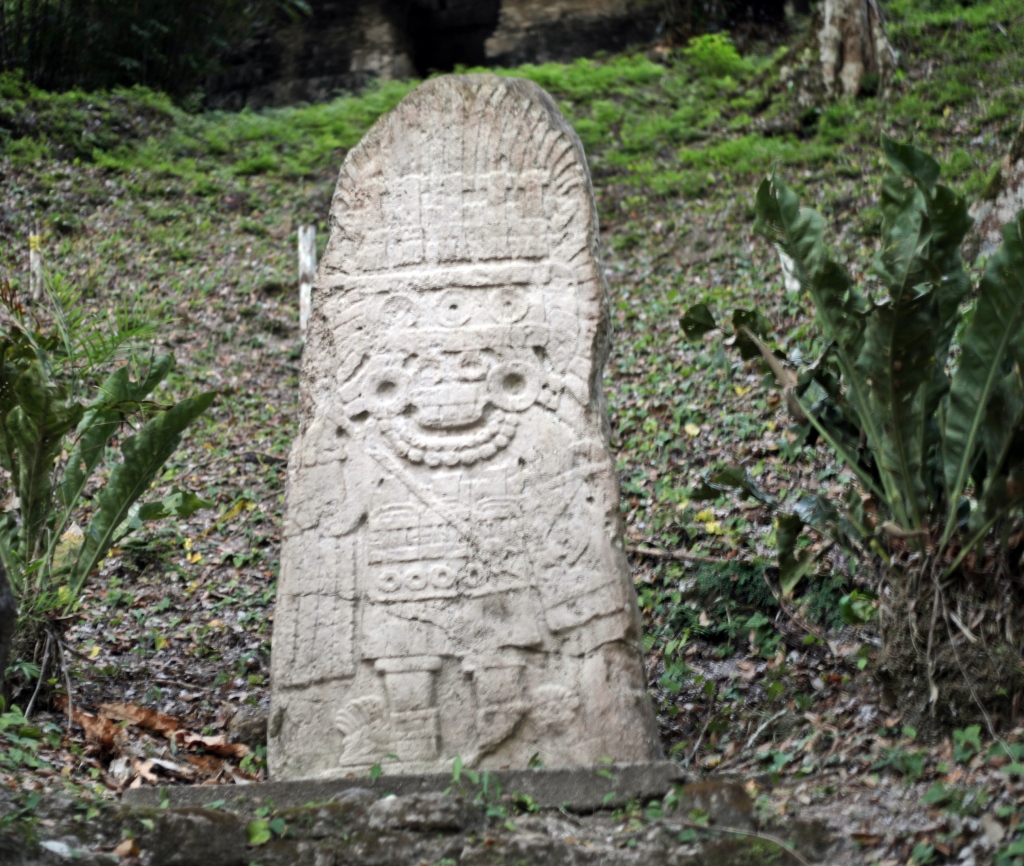
Maler Plaza
Set a part from the rest of the city is Maler Plaza (also called Plaza of Shadows). Its main temple is a stepped pyramid and has different look than most pyramids we have seen in other cities. This plaza is believed to have been the site of religious ceremonies.
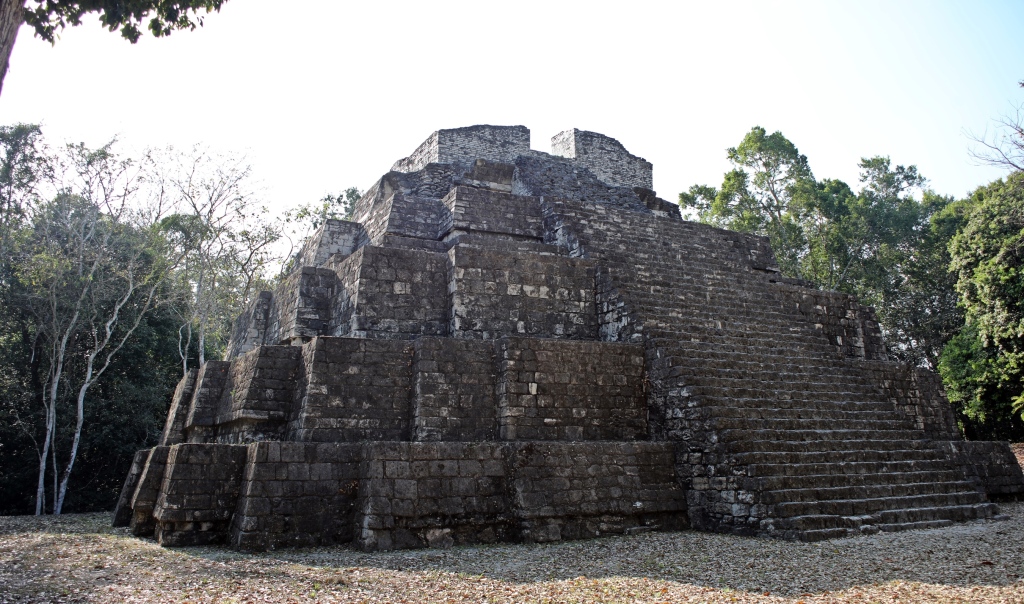
Wildlife in Yaxha
As we walked through the jungle between the different plazas the roar of howler monkeys came from the trees. When we moved away from the howler monkeys, we saw spider monkeys swinging from branch to branch. Between Tikal and Yaxha we saw more wildlife than on some safaris we’ve been on.
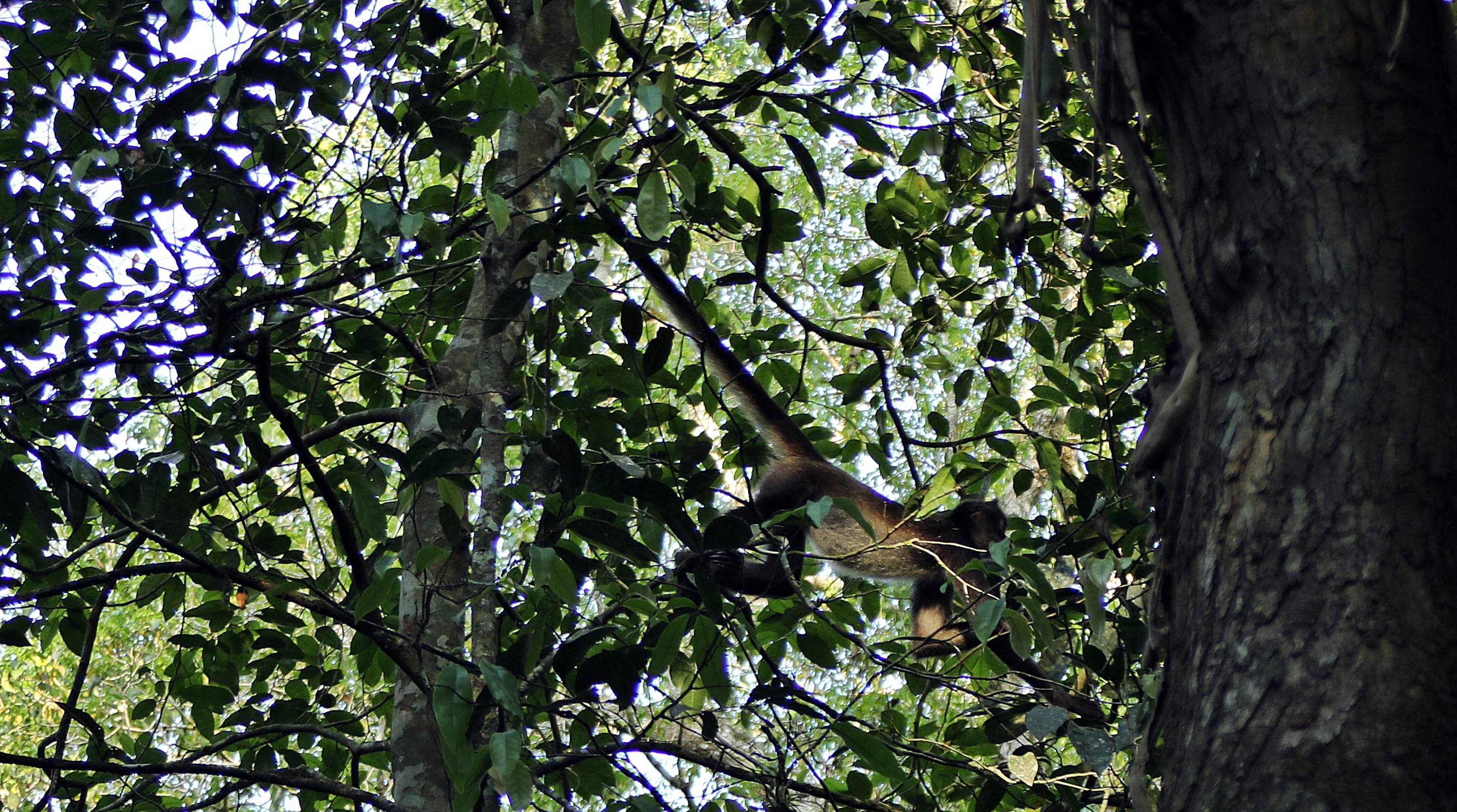

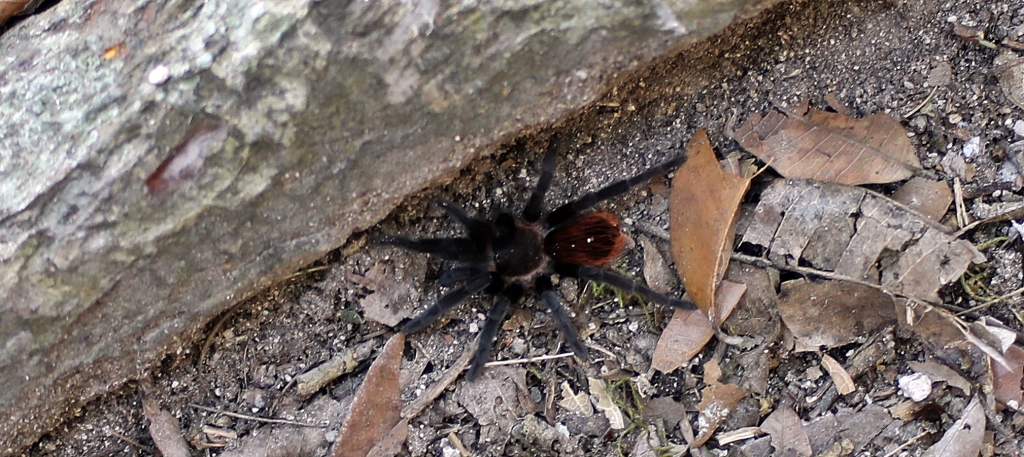
In the video below you can see the spider monkeys swinging in the trees while hearing howler monkeys roaring in the background. Turn on the volume if you want to hear the howlers.
Temple 216
The last pyramid we visited was Temple 216. Built in the 8th century, it is also called Red Hands because red coloured hand imprints were found on the walls. A long wooden stairway took us to the top, 30 m above, where we had a gorgeous view of Lakes Yaxha and Sacnab and as the sun set behind.
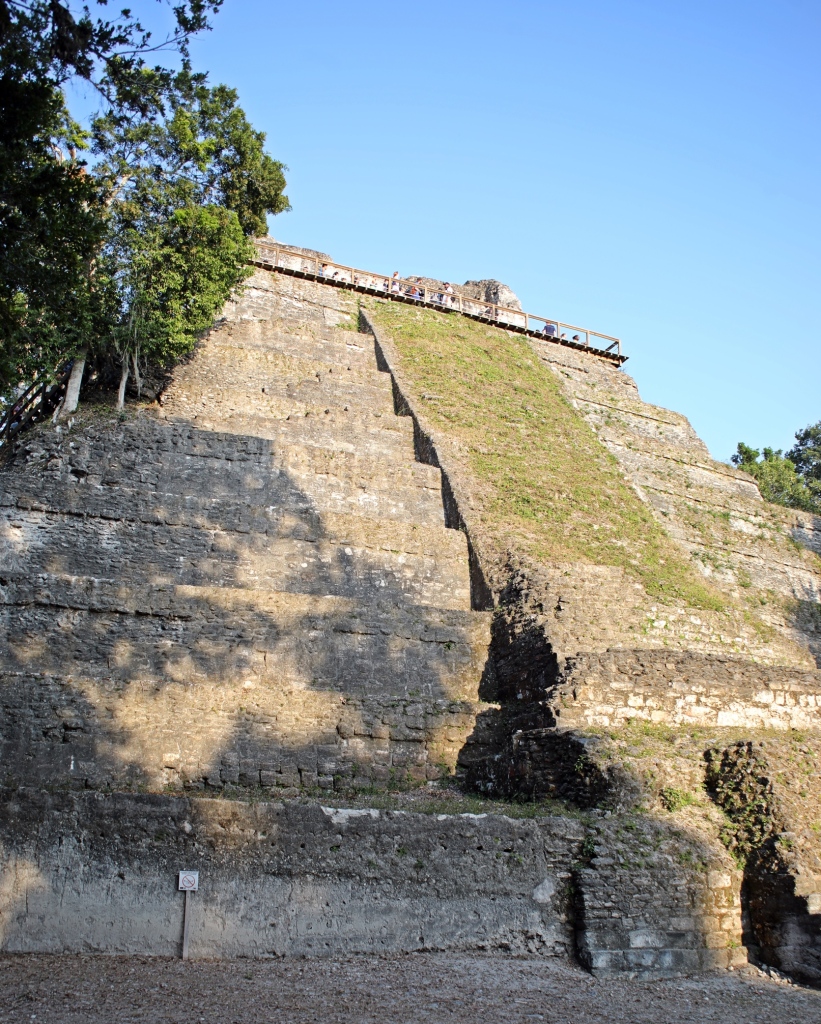

Entrance Fee – 80Q ($10 USD); Opening Hours – 8am to 6pm
If you have time and are interested in visiting more Mayan ruins while in Flores, there are two other sites that can be visited. The closest is Uaxactun, which operates as a national park but hasn’t received much restoration work. The other is El Mirador which can only be reached by a five-day jungle hike or helicopter. El Mirador has the tallest pyramid known in the Mayan world at 73 m (230 ft) high.
How to Visit Tikal and Yaxha
While we usually prefer to visit sites on our own, we decided to use a guide for both Yaxha and Tikal and we’re glad we did. Tikal is a massive archeological site and it would have been difficult to find all of the important buildings on our own. Yaxha may have been easy to explore on our own, but the information signs are only written in Spanish so it would be difficult to learn much about the different buildings and the city’s history without a guide.
If you visit during the summer months temperatures can easily reach 40° C. There is no where to buy water or food in Yaxha so make sure you bring your own. There are a few tourist shops and a cafeteria in Tikal if you forgot to bring water, but as you would expect, it’s very expensive. At both sites, the ground is very uneven so wear good footwear.
Best time to visit Tikal & Yaxha
Dry season is the best time to visit but, in this part of Guatemala it only last three months. Dry season runs from March to mid May. The rest of the year is rainy season.
Where to stay when visiting Tikal and Yaxha
Instead of a quick trip to see the ruins, we suggest staying for a couple of day in the island town of Flores. It has easy access to the ruins of Tikal and Yaxha as well as being a pretty, town filled with colourful colonial buildings. You can find a good selection of hotels, guesthouses and restaurants in the island town. You can read more about this cute town in our post A Visit To Flores.
For those who don’t have much time, there are a few hotels near the entrance to Tikal.
How to get to Flores
The colonial town is on Guatemala’s tourist triangle that includes Antigua and Lake Atitlan. This means that there are many ways to reach Flores. Mundo Maya International Airport receives flights from Guatemala City as well as Mérida and Cancún in Mexico. Buses and tourist shuttles connect Flores with Guatemala City and Antigua as well as smaller centres like Rio Dulce, and Lanquin. We booked our tourist shuttles with Green Monkey Hostel in Flores and Tropicana Hostel in Antigua.
Many people travel to Flores from Belize because its proximity to the border. There are several tours and buses to/from San Ignacio and Belize City. There is also a tourist shuttle from Chetumal and Bacalar, Mexico (links coming soon), which is how we arrived. It is operated by Marlin Espadas and was very efficient and safe option.

To read more of our adventures in Guatemala, click here.
Coming Next – Three Relaxing Days on Rio Dulce, Guatemala
For pictures from other blogs go to Gallery at monkeystale.ca
To read about more of our adventures go to Destinations.
If you like what you read, please comment or share (with credit) using the links below.
These photographs are like images from a time machine. The pyramids and temples are awe-inspiring.
LikeLiked by 1 person
They are very impressive pyramids, I can imagine how overwhelming it must have been when they were at their best. Maggie
LikeLiked by 1 person
Tikal was such an amazing place. Thanks for reminding me of my trip. I do remember sweating like a pig in the early morning and hearing those howling monkeys! Hot hard climbs but wouldn’t change it for the world!
LikeLiked by 1 person
Tikal’s amazing, isn’t it?! You must be getting ready to sweat it out in Uzbekistan soon too!
LikeLike
Two weeks and 2 days to go!!! 🤣🤣🤣
LikeLiked by 1 person
Wow! Very impressive as is the fact that there were 3,000 buildings and 60,000 people at one time. Another post that makes me wish we could go back in time to see these places. But avoid the drinking water.
LikeLiked by 1 person
Wouldn’t it be great to travel in time, but be able to bring your own water bottle 😊 Thanks! Maggie
LikeLiked by 1 person
Fine sharing of information…very nice pictures, Maggie!
LikeLiked by 1 person
Thank you Indira, glad you enjoyed Tikal! Maggie
LikeLiked by 1 person
I’m always so fascinated by ancient civilizations. Can’t imagine life without chocolate or vanilla! I agree that these sights are best to see with a guide so you can get the full story of what you’re looking at. Great recap!
LikeLiked by 1 person
I am always surprised at what they could build and design in ancient times. And especially cultivate- chocolate, vanilla, chilis, they ate well too 😊 Thanks Lyssy! Maggie
LikeLike
Beautiful post and photos Maggie. The example of the Maya should give us all pause that all great civilizations can fall. Wonderful feats of engineering for the time and yet they were defeated by the lack of basic necessities. Nothing lasts forever. Have a good Friday Maggie. Allan
LikeLiked by 1 person
So true, they were likelybtaken down by water contamination, which they did to themselves. Thanks for your comment Allan!! Maggie
LikeLiked by 1 person
Well as a lover of chocolate, vanilla, and especially pineapples, my thanks to the Mayans haha!
On a more serious note, this is incredible. I can’t believe how large the city was or how long it remained a powerful place. Their advanced knowledge is also just so amazing to me. Pat and I were discussing this recently, apparently they were even able to predict solar eclipses!
I may have just missed it, but are there any dwelling units visible here, or is it just the pyramids?
LikeLiked by 1 person
Their calendars were very extensive and very accurate given their tools at the time. And their cultivation of chocolate and pineapples, is more than impressive and appreciated, I love pineapples too! Their homes would have been made from clay so none have survived that they know of. I think they’ve only been found at Joya de Cerén in El Salvador.
LikeLiked by 1 person
It’s sad that a great civilization disappeared. But, at least, some of its wonders have been preserved.
LikeLiked by 1 person
Yes, thankfully they land was too poor for the Spanish to invade and destroy these pyramids. It must have been a very impressive city at the time. Thanks Neil, Maggie
LikeLiked by 1 person
I visited Tikal sometime in the mid 70’s when the civil war was raging. Tikal was already protected at that time so wildlife was abundant, but little excavation had been done. The entire park was minimally developed. We had to walk a long distance just to get there. The few rules, such as not climbing the pyramids, were not enforced, so one morning we decided to climb a very tall steep temple, perhaps the temple of the jaguar. At the top we discovered that there had been a recent sacrifice of a (presumed) virgin. In the shallow bowl at the very top, which was intended to capture the blood of sacrificial victims, we discovered a used condom!
LikeLiked by 1 person
I guess it had different uses in the 70s! The site and the country was likely a lot different then compared to now. I was surprised that we could climb any of the pyramids, since it is likely slowly destroying them. Thanks for sharing your story 🙂 Maggie
LikeLike
This was a wonderful tour. Your photos are splendid!🌺
LikeLiked by 1 person
Thanks so much Kymber!
LikeLiked by 1 person
i just re-followed your blog Kymber. Seeing your comment made me realize that I wasn’t getting any notices. Maybe this time will work. Maggie
LikeLiked by 1 person
I hope so, Maggie! 🙂 WordPress is sure glitchy. I’ve run into this, too.
LikeLike
WOW Maggie, these are some awesome and detailed shots of these ruins. I love them! The trees and animals are the icing on top of the cake! 📸🌳💖🦜🐵
LikeLiked by 1 person
Thanks Kym, it’s a pretty spectacular site. Ruins and wildlife viewing all in one 🙂 Maggie
LikeLiked by 1 person
What amazing experiences you have on your travels and your photos are a wonderful added bonus my friend. 📸 I appreciate ya! 🤗💞🥰
LikeLiked by 1 person
We really enjoyed seeing similar Mayan ruins in Cancun, MX. Great pictures, Maggie.
LikeLike
Not only an interesting place, but from your photos it doesn’t appear overrun by tourists.
LikeLiked by 1 person
It wasn’t very busy at all and both sites are so large that the people who are there are spread out.
LikeLiked by 1 person
Great article on Tikal, you really did your research. Good photos!
LikeLiked by 1 person
Thanks so much Rebecca! Maggie
LikeLiked by 1 person
The Mayan Civilization has always fascinated me. How amazing to be able to stand among the remnants of their world!
LikeLiked by 2 people
Seeing these Mayan pyramids was amazing. They were such an advanced civilization, and seeing what they built added to my admiration for them. Thanks Rosaliene, Maggie
LikeLiked by 1 person
My joy, Maggie 🙂 ❤
LikeLiked by 1 person
So interesting how all great civilizations did rise and fall in time, the Mayan one too..
LikeLiked by 1 person
It is, and you never know what the cause will be. 🙂
LikeLiked by 1 person
Never mind the ancient buildings – that toucan! Wonderful.
LikeLiked by 1 person
Haha, yes we could have watched it all day!
LikeLike
Fantastic post, Maggie, very informative. I find the history of the Mayan civilisation fascinating. There must have been a critical reason for abandoning these complex cities and contaminated water sounds like a logical cause for it, especially given how quick it seemed to be.
LikeLiked by 1 person
It does sound like the most likely theory lately. They were fascinating and advanced people. Thanks Lynette! Maggie
LikeLiked by 1 person
I need to learn more about the Mayans. They certainly were an intriguing people. It’s interesting that your guide said they were not empire builders. Perhaps that is why they were so advanced. Their concentration was on math and science rather that greed and acquisition. Another great post, Maggie.
LikeLiked by 1 person
Good point, they let their minds grow and develop rather than be consumed by greed. We could learn from them. Maggie
LikeLiked by 1 person
What a fascinating history lesson to wander through so many Mayan ruins. It is really amazing how well built all the temples were to have survived so long.
LikeLiked by 1 person
It’s fascinating to see these massive pyramids in person and realize how long ago they were built. Thanks Meg, Maggie
LikeLiked by 1 person
These are all so interesting; they must have had quite a huge construction crew! How fortunate to see pyramids and wildlife in one location.
LikeLiked by 1 person
I’m sure there were a lot of slaves to do the work, but it must have been quite the undertaking. The jungle, the pyramids and the wildlife – they are great sites! Maggie
LikeLiked by 1 person
What a glorious journey you undertook Maggie. Wowee, these pyramids are all spectacular. Great photos of them all. I lost track of a favourit after the fifth pyramid (the Necropolis). The amazing construction and great stone structures, just to imagine how much effort it took just to get the stone and materials in to build the pyramids and then the creativity to build so high. Amazing. I wonder where they got their stone (looks like limestone, I am guessing, I don’t know) from to build the pyramids.
Also I see that you mentioned that visitors were allowed to climb the temple of Mask Pyaramids and a few others. How do they get to the top I wonder, (I did not see anyone on the stairs except at the North Acropolis, in the photos)?
Love the view from Lost World Pyramid, so impressive how much the jungle has taken over the area yet the pyramids can still be seen. I love the native trees and critters, so cute. Some of them look very used to people, they are close up in the photos.
Love the forest sounds in the video quite an exciting symphony…LOL.Wonderful.
Are there places to stay in Tikal? I wonder the are seems quite well managed?
I could go on as I said, I enjoyed the entires share. I appreciate the excellent tips, history and crops (chocolate…who knew it began here).
Great share, as always Maggie. I enjoyed it. Safe travels.
LikeLiked by 1 person
Glad you liked Tikal and Yaxha, they are amazing historical sits. The pyramids are mostly built from limestone as well, the mortar is made from limestone dust. The entire basin that they lived on was composed of limestone ridges, so it was plentiful. For the three pyramids that you can climb in Tikal there are wooden stairs up the back side. At Yaxha it was a combination of climbing on the original stone staircases and wooden ones. I was really surprised that this was still allowed as it must to damage them. But I’m glad for the views that we had from their tops. It was amazing to see the tall pyramids above the jungle.
It was also so amazing to see such a healthy jungle filled with monkeys and birds. They did seem to be used to people and the spider monkeys seem to be following us around for a while. But I don’t think they’re looking for food, they just seemed curious.
There are a couple of hotels just outside Tikal’s park gates, but not with in the site, and nothing at Yaxha.
Thanks so much for your detailed questions Suzette! It’s a great setting for one of your action-packed stories 🙂 Maggie
LikeLiked by 1 person
Thank you, Maggie, for the wonderful detailed reply. I am glad to hear that the pyramids have constructed some staircases to project the older limestone.
Ah, yes, it would make a fabulous story setting….hmmm, excellent idea!!
Safe travels Maggie. A pleasure!
LikeLiked by 1 person
Such an amazingly thorough and informative account.
LikeLiked by 1 person
Thank you! Maggie
LikeLike
Talk about a lost world, Maggie! These are amazing, aren’t they? I sometimes wonder if the best of our human race isn’t all in the past.
LikeLiked by 1 person
Ha, yes it seems that way doesn’t it! Although the Mayas were also very vicious. I’ll talk about that at other sites we visit. Thanks Jo! Maggie
LikeLiked by 1 person
Unbelievable feats of engineering for the time period of the pyramids Maggie.
LikeLiked by 1 person
It was, they were great builders. Thanks for your comment! Maggie
LikeLike
You’ve taken me back to my own visit to Tikal and brought back lots of memories – thank you 🙂 Even though it was quite some years ago I was already having some issues with walking, so I was proud of myself for managing to climb Temple IV but I left the others to Chris! Like you we had a guide and I agree, it’s definitely worth doing so there! We didn’t get to Yaxha however so I especially enjoyed your section on that site. And I was fascinated, as you can imagine, by the links to Teotihuacan!
LikeLiked by 1 person
I knew you’d like the Teotihuacan reference, there are actually quite a few throughout the Mayan sites in Yucatan too. The Teotihuacans were great travellers. Even though Yaxha was small by comparison, we really enjoyed it. The Maya built very pretty cities, I guess the lush jungle setting of most of them helps.
LikeLiked by 1 person
These Mayan ruins are impressive. It’s incredible to hear that only 10% of the ruins of Tikal have been uncovered. I got a good laugh about Lord Chocolate. With a name like that, no wonder he was considered the best ruler.
LikeLiked by 1 person
How could he not be the best ruler with a name like that!!! 😊 We walked by a lot of mounds covered in jungle that were likely Mayan buildings. It’s too bad that most of them will never be uncovered. It must have been an amazing city in its time. Thanks Linda! Maggie
LikeLiked by 1 person
These places are fascinating, enchanting and mystical to visit. Having visited quite a few on our tour of Mexico, one of the lasting impressions is the depth of knowledge which had been acquired by these ancient races, Mayans among them. Geographical, mathematical and astronomical knowledge without reference books or any other source, thus knowledge acquired or developed independently. All this simply adds to the feeling you get at such places, just imagining what the cities were like in their heyday.
LikeLiked by 1 person
They were remarkable people, so advanced for what we tend to think of that time. What we found interesting was that each site, Mayan, Mexica, Zapotec etc, were different from each other so we didn’t get ‘ruined-out’. It would have been amazing to see at their peak. Maggie
LikeLiked by 1 person
Spectacular! I don’t know if I’ll make it to Guatemala one day to see Tikal and Yaxha, but I will never say never. With the limited days off I get from work, I’m more focused on making a trip to Mexico (especially the Yucatan peninsula) happen sooner than later. The wildlife you saw in the forests surrounding those Mayan pyramids are stunning. How lovely that you even spotted toucans!
LikeLiked by 1 person
They Yucatan has some amazing Mayan sites too, and the rest of Mexico is filled with ruins from other cultures that first lived in Mesoamerica. I know how much you love these kind of sites so I hope you do get to both Mexico and Guatemala. Maggie
LikeLiked by 1 person
These remind me so much of the Mayan ruins we visited in Mexico – like ancient ruins throughout the world I’m always fascinated to imagine what it would be like to live back then, living in those places. And the wildlife. I confess that would have been the greatest draw for me, especially the toucans!
Alison
LikeLiked by 1 person
It would be amazing to step back in time for a few days to see wouldn’t it? Honesty, the amount of wildlife we saw between the two sites was more than we’ve seen on some safaris. The toucans were so close to us too, amazing! Thanks Alison! Maggie
LikeLiked by 1 person
What a fantastic post…really enjoyed this. What an amazing journey you must be having….I am not in the least but jealous…
LikeLiked by 1 person
Thanks James, Guatemala was great, so much to see in the little country. Maggie
LikeLiked by 1 person
Wonderful, always wanted to go there
LikeLiked by 1 person
Thanks, they are really incredible sites. Maggie
LikeLike
your 100th like. Wow. I lovelovelove this post too. Long but so worth it. Wow again. 👏🏽
LikeLiked by 1 person
Thanks!! The next two will be shorter, I promise 🙂 There was just too much to share about these sites 🙂 Maggie
LikeLike
I devoured it. It’s so good. 👏🏽 thanks for all you work you put into your posts. Wow
LikeLiked by 1 person
Fascinating post, Maggie. A place I’d love to explore. You put a lot of work into your posts and your enthusiasm for the topic shines through. I am thankful Mayans invented chocolate. 🙂
LikeLiked by 1 person
Thanks so much Jane, Tikal and Yaxha are both fascinating sites, made even better with chocolate 😊 Maggie
LikeLike
Wonderful photos!
LikeLike
I’ve long forgotten what I learned about the Mayans in school, so I truly appreciate this refresher course. The pyramids are utterly amazing!. Thank you for the fabulous images of them. 🙂
LikeLiked by 1 person
It was so fascinating to learn more of the Mayas. They were so advanced bringing us these amazing pyramids as well as chocolate 😊 Thanks Nancy, Maggie
LikeLiked by 1 person
I loved Tikal. I found it to be one of my favorite Mayan ruins and we really had it all to ourselves when we went. Such an amazing part of the world.
LikeLiked by 1 person
It’s amazing isn’t it? The Mayans were so advanced. Between the ruins and the wildlife, we loved Tikal too. Thanks for your comment 😊 Maggie
LikeLike
Mayans were so much smarter than we give them credit for. Excellent article.
LikeLiked by 1 person
Thank you Jacqui, they were very advanced and you’re right, they don’t get enough recognition. Maggie
LikeLiked by 1 person
Incredible how tall those temples are! It would be impossible to tell through a pic without the contrast to the trees and people around them. Great job.
LikeLiked by 1 person
Thank you! They are both spectacular sites and the temples are incredible, especially seeing them above the trees. Maggie
LikeLiked by 1 person
Mesoamerican history is long, massive, and complex. I learned a lot about it a couple years ago when we toured some of the Mexican sites. It seems like Tikal was ground central for a good chunk of it – it must have been amazing to see it in person. It would have been interesting to see the whole area circa AD 700 when things seemed to be peaking. (Invisibly, with an interpreter. Chances are a strange visitor might just be offered up to the gods…)
LikeLiked by 1 person
Yes, you may find yourself being forced to a life-ending Ball Game. But I agree, it would have been amazing to see these sites in their prime. Tikal was an important site for a lot of the Mayan’s history, until they poisoned themselves that is. Noting lasts forever. Thanks Dave! Maggie
LikeLiked by 1 person
I actually visited a Mayan ruin on my honeymoon. So long ago, almost 31 years ago, I remember very little about it 😊.
LikeLiked by 1 person
Well time for a revisit 😊
LikeLiked by 1 person
Looks like it!
LikeLike
Such a detailed and informative write up thanks for sharing. I heard about the Mayans but only now realise how specially evolved and advanced they were it sounds almost magical. Am so amazed about their calendar made of ‘365 days separated into eighteen 20-day months and one 5-day month’… thats so fascinating!
LikeLiked by 1 person
They were incredibly advanced especially in math and astronomy. How they figured out a calender year is mind boggling isn’t it!?
LikeLike
Totally amazing and so other worldly. The video of the howler monkeys sounds like there is hundreds of them. You have peaked our interest to do a re-visit to Guatamala. From here in Colombia it’s easy to get to. What place did you stay in Flores if you recommend it. Cheers!
LikeLiked by 1 person
The howler monkeys were so loud, I’m glad I recorded them. We really loved Guatemala, so I would always recommend it. But I wouldn’t really recommend our hotel. The problem was that all of the rooms opened up to the outside so it was quite noisy. But I’d recommend to stay somewhere around the opposite side of the island to the causeway. We booked our tour guides at Green Monkey hostel and they provide really good services for reasonable price. It wasn’t a typical hostel tour with a bunch of young people partying 🙂
LikeLiked by 1 person
muchas gracias!
LikeLiked by 1 person
Thank you so much for this incredible post, Maggie! I will be sharing with my adventurous daughter as I know she would love to visit this area.
LikeLiked by 1 person
Oh great! Let me know if she has any questions.
LikeLiked by 1 person
I will, thank you for that offer. I am sure she will get lots of ideas by reading your blog. 👍🏻
LikeLike
Just wow! It looks like a fascinating site, so much interesting history and hardly any tourists! The Mayans were truly incredible with their abilities so long ago. Thanks for sharing Maggie 🙂
LikeLike